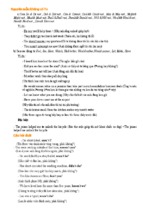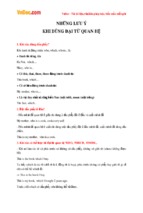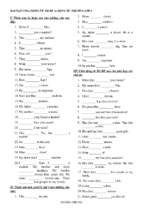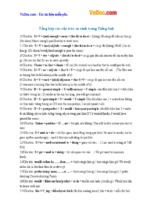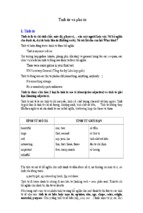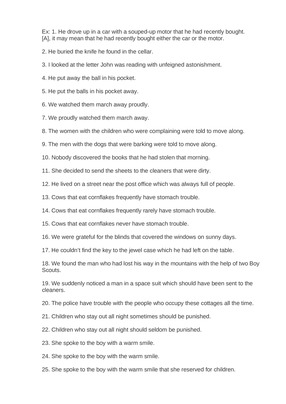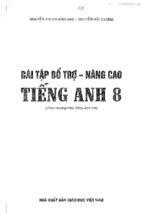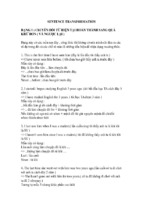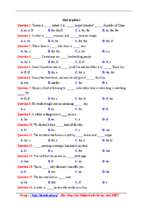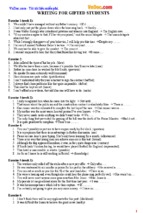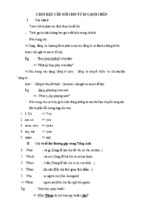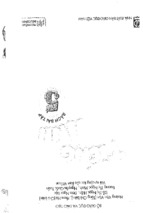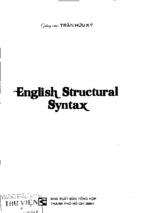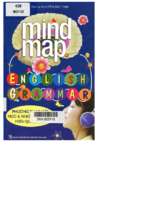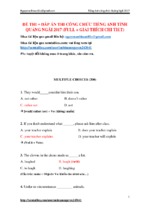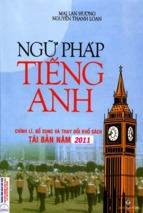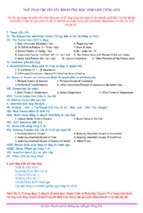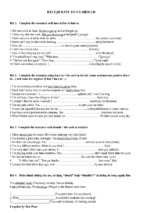Là 1 bộ sách ngắn , được xuát bản tại anh với nhiều dạng bài tập khác nhau dành cho giáo viên và học sinh
Practice Test
for the
TOEFL Junior™ Standard Test
®
Part of the TOEFL® Family of Assessments
Contains one full practice test
No part of the TOEFL® Junior™ Standard Practice Test book may be reproduced or transmitted in any form or by any means,
electronic or mechanical, including photocopying, recording, or any information storage and retrieval system, without permission in
writing from the publisher. The publisher reserves the right to prosecute violators in accordance with international treaties and the
trademark and copyright laws of the United States and other countries. Direct permission requests to www.ets.org/legal.
Notes to the User
The TOEFL® Junior™ Standard test practice materials used in this book were created
by professional test developers at ETS. The test questions in this practice book are
an accurate reflection of the questions found in an actual TOEFL Junior Standard
test book.
The ideas expressed in the reading materials contained in the practice test do not
necessarily reflect the opinions of the TOEFL Board or Educational Testing Service
(ETS®).
The TOEFL® Junior™ Program does not operate, endorse, or recommend any schools
or study materials that claim to prepare students for the test in a short time or promise
high scores. Any use of material in this book by a school or study program does not
mean that it has been endorsed by ETS or the TOEFL® Junior™ Program.
In order to complete the listening section of the practice test, you will need to access
the following website for the audio files: http://www.ets.org/toefl_junior/practice_test.
Copyright © 2012 by Educational Testing Service. All rights reserved. ETS, the ETS logo and TOEFL are registered trademarks of Educational Testing Service (ETS)
in the United States and other countries. TOEFL JUNIOR is a trademark of ETS. Other trademarks herein are the property of their respective owners.
Table of Contents
About the TOEFL® Junior™ Standard Test . . . . . . . . . . . . . . 3
What is in the Test? . . . . . . . . . . . . . . . . . . . . . . . . . . . . . . . .
Listening Comprehension Section . . . . . . . . . . . . . . . . . .
Language Form and Meaning Section . . . . . . . . . . . . . . .
Reading Comprehension Section . . . . . . . . . . . . . . . . . . .
4
4
4
5
Preparing for the TOEFL® Junior™ Standard Test . . . . . . . .
Taking the Practice Test . . . . . . . . . . . . . . . . . . . . . . . . . .
General Study Tips . . . . . . . . . . . . . . . . . . . . . . . . . . . . . .
Here are some tips for improving your
listening skills . . . . . . . . . . . . . . . . . . . . . . . . . . . . . . .
Here are some tips for improving your
language form and meaning skills . . . . . . . . . . . . . . . .
Here are some tips for improving your
reading skills . . . . . . . . . . . . . . . . . . . . . . . . . . . . . . . .
Use proven test-taking strategies . . . . . . . . . . . . . . . . .
6
6
6
6
7
7
7
Answer Sheet . . . . . . . . . . . . . . . . . . . . . . . . . . . . . . . . . . . . 8
Completing Your Answer Sheet . . . . . . . . . . . . . . . . . . . . 8
Practice Test Answer Sheets . . . . . . . . . . . . . . . . . . . . . . . 9
Practice Test . . . . . . . . . . . . . . . . . . . . . . . . . . . . . . . . . . . .
Listening Comprehension Section . . . . . . . . . . . . . . . . .
Language Form and Meaning Section . . . . . . . . . . . . . .
Reading Comprehension Section . . . . . . . . . . . . . . . . . .
13
15
25
39
Review Materials . . . . . . . . . . . . . . . . . . . . . . . . . . . . . . . .
Answer Key . . . . . . . . . . . . . . . . . . . . . . . . . . . . . . . . . . .
Listening Comprehension Script . . . . . . . . . . . . . . . . . . .
Taking the TOEFL® Junior™ Standard Test . . . . . . . . . .
53
55
57
69
About the TOEFL® Junior™ Standard Test
English-language proficiency is an increasingly important skill for students worldwide as it provides access to a wide
range of educational, personal and professional opportunities. Reliable assessment of progress in English language
learning at a young age is crucial for student development.
Market research indicates a global need for a well-designed, objective measure of proficiency in English to help younger
students, specifically in middle-school grades.
Educational Testing Service (ETS) developed the TOEFL® Junior™ Standard test for the English language learning needs
of students in middle-school grades, usually ages 11–15.
The TOEFL® Junior™ Standard test measures the degree to which middle school students have attained proficiency in the
academic and social English language skills representative of English-medium instructional environments. It is not based
on or limited to any specific curriculum. Designed to measure listening comprehension, language form and meaning,
and reading comprehension, the test gives schools, teachers, parents, and students an objective measure of the test taker’s
English language learning progress. Scores can be used to support decisions to place students into programs designed to
increase English proficiency levels. The test can also be used to measure student progress in developing English language
proficiency over time.
Taking the practice test in this book will help you identify any areas where you need improvement. You can use the
“General Study Tips” section of the book to help you prepare for the actual test. The practice test will also help you know
what to expect when you take the TOEFL® Junior™ Standard test — you will be familiar with the types of questions and
how to mark your answer sheet. You will not receive a final score for the practice test.
There are no passing or failing scores set by ETS for the TOEFL® Junior™ Standard test — each school decides for itself
what scores are acceptable for its purposes.
3
What is in the Test?
The questions on the TOEFL® Junior™ Standard test are multiple-choice questions, each with four possible answers.
There are three sections, each measuring a critical skill in the use of English. Each section has 42 questions, and total
testing time is approximately two hours. All questions are placed in the context of a school environment.
Listening Comprehension Section
The Listening Comprehension section measures your ability to listen for instructional, social, and academic purposes.
The section contains three different question types, each designed to meet one of these purposes:
■
Classroom Instruction. In this question type, you will listen to a short talk by a teacher, principal, librarian, or other
school staff member. Each talk lasts 20 to 45 seconds. After the talk you will answer one question. The question
may ask you to identify the main idea or the purpose of the talk, or make an inference or prediction based on what
the speaker says.
■
Short Conversation. In this question type, you will listen to a conversation between two students or between a
student and a school staff member, like a teacher or librarian. The conversations last 60–90 seconds. After the
conversation, you will answer 3–4 questions. The questions may ask you to identify the main idea or one of the
important details of the conversation; to make an inference or prediction based on the conversation; to identify why
a speaker talks about certain information; or to recognize how a speaker feels or what a speaker means when using
certain intonation or stressing certain words.
■
Academic Listening. In this question type, you will listen to a classroom lecture or discussion about an academic
topic. After you listen, you will answer 4–5 questions. The question may ask you to identify the main idea or one
of the important details of the lecture or discussion; to make an inference or prediction based on the lecture or
discussion; to identify why a speaker talks about certain information; or to recognize how a speaker feels or what a
speaker means when using certain intonation or stressing certain words.
Language Form and Meaning Section
The Language Form and Meaning section measures your understanding of the structure of English and the depth of
your vocabulary knowledge. The questions are presented within a series of short paragraphs. Each question requires
you to choose the correct word or phrase that accurately completes a sentence. Each paragraph represents the kinds of
reading that students do in a school context:
■
Emails, notes, or announcements
■
Short fictional passages
■
Student reports
■
Magazine articles
■
Passages from textbooks
There are two main types of questions. Language Form questions test knowledge of grammatical structures (for
example, verb tenses, relative clauses, word order, adjective or adverb form). Language Meaning questions test
knowledge of vocabulary.
4
Reading Comprehension Section
The Reading Comprehension section measures your ability to read and comprehend both academic and non-academic
texts that you might come across in a school environment. Examples of non-academic texts include:
■
Correspondence (emails, notes, and letters)
■
Non-linear texts (schedules and menus)
■
News articles (like those found in a school or local newspaper)
Examples of academic texts include:
■
Narratives about fictional characters
■
Persuasive texts that support an opinion (letters to the editor and movie or book reviews)
■
Passages about an academic topic that might be found in a textbook or specialized magazine
The questions in the Reading Comprehension section test your ability to:
■
Comprehend the main idea of a text
■
Identify important factual information that supports the main idea
■
Make inferences based on what is not explicitly stated in a text
■
Determine the meaning of unfamiliar words or expressions from context
■
Identify the words that pronouns represent
■
Recognize an author’s purpose
5
Preparing for the TOEFL® Junior™ Standard Test
Taking the Practice Test
Taking the practice test in this book will give you a good idea of what the actual test is like in terms of the types
of questions you will be asked and the time limits you will have. You will have 40 minutes to complete the
Listening section, 25 minutes to complete the Language Form and Meaning section, and 50 minutes to complete
the Reading section.
Each section begins with a set of special directions that includes sample questions and answers. It is important to read
these directions so you will understand exactly what you are to do before you start to work on a section.
Some questions may be harder than others, but try to answer every one. If you are not sure of the correct answer,
make the best guess you can and go on to the next question. It is to your advantage to answer every question, even if
you have to guess. There is no penalty for guessing.
As you take the practice test, work rapidly but carefully. Do not spend too much time on any single question. You may
take notes only during the Listening section.
Here are more guidelines for using the practice test:
■
Plan to spend approximately two hours without interruption to take the practice test
■
Choose a quiet room in which to work
■
Use a stopwatch or a clock so you can know the correct amount of time
■
Have two sharpened No. 2 or HB black lead pencils and an eraser
■
Remove any study materials from your work area
General Study Tips
Here are some tips for improving your listening skills:
■
Watching English-language movies and television programs and listening to English-language radio provide
excellent opportunities to build your listening skills. English-language recordings are equally valuable and helpful.
The Internet is also a great resource for material that you can use to improve your English listening skills.
■
Listen carefully to what the speaker is saying.
■
Stay active by asking yourself questions. For example, what main idea is the speaker communicating?
■
Think about what the speaker is doing. In other words, what is the purpose of the speech or conversation? For
example, is the speaker apologizing, complaining, or making suggestions?
■
Is the speaker’s voice calm or emotional? What does the speaker’s tone of voice tell you?
■
Pay careful attention to the way stress and intonation patterns are used to convey meaning.
■
Think about how a talk or discussion is organized. Listen for signal words that indicate the introduction, major
steps or ideas, examples, and the conclusion or summary.
■
Listen for words that show connections and relationships between ideas (for example, “because,” “however,”
“therefore”).
■
Listen to recorded material and stop the recording at various points. Predict what information or idea will be
expressed next.
■
During or after the lecture, create an outline of the information discussed.
6
Here are some tips for improving your language form and meaning skills:
■
Read a text first for meaning. Then, review the same text, this time paying attention to the different ways the
sentences are structured.
$$ In each of the sentences, determine the part of speech that each word represents. Try to identify the
subject, verb, object, adjectives, adverbs, prepositions, determiners, and conjunctions. Also, try to
identify the verb tense.
$$ Find out how other parts of the sentence are related to the main clause by looking for structural clues
such as connectors or punctuation marks.
$$ Look for transitional words such as “because,” “however,” and “therefore.” Pay attention to how these
words connect ideas across sentences.
■
Increase your vocabulary, learning 6 or 7 new words every day. Keep a growing list of words and review the entire
list from time to time to make sure you do not forget the meanings of the words.
■
Keep an English-language journal. Spend a few minutes every day writing in your journal.
$$ If you are taking English classes at school and learning grammar, make a point of using new
grammatical structures you have learned when you write.
$$ Once you have completed an entry, make sure to go back and re-read what you have written. Revision is
the key to improving writing. Correct any errors that you find. Highlight areas you are unsure about and
ask questions about them in class.
Here are some tips for improving your reading skills:
■
Read a few pages in English every day. Read a variety of English-language texts, including short stories,
newspaper and magazine articles, and non-fiction texts about academic topics such as science, social studies, and
arts. Many such texts can be found on the Internet.
■
Practice skimming a passage quickly to get the main idea. Develop the ability to skim quickly and identify
major points.
■
After skimming a passage, read it again more carefully and write down the main idea, major points and
important facts.
■
When you come across an unfamiliar word, try to determine the meaning from the context. If you cannot determine
the meaning from context, look up the meaning of the word in a dictionary.
■
Underline all pronouns (he, him, they, them, etc.) and identify the nouns to which they refer in the passage.
Use proven test-taking strategies
■
Carefully follow directions in each section of the test to avoid wasting time.
■
Don’t panic. Concentrate exclusively on the current question only. Don’t think about how you answered other
questions. This is a habit that can be learned through practice.
■
Avoid spending too much time on any single question. If you have given the question some thought and you still
don’t know the answer, eliminate as many choices as possible and then select the best choice.
7
Answer Sheet
Completing Your Answer Sheet
When you mark your answers on the answer sheet:
■
Use a No. 2 or HB black lead pencil.
■
Mark only one answer to each question.
■
Be sure to mark your answer in the row with the same number as the question you are answering.
■
Carefully and completely fill in the circle corresponding to the answer you choose for each question. If you change
your mind about an answer after you have marked it on your answer sheet, completely erase your old answer and
then mark your new answer.
Taking the practice test:
■
Remove one of the sample answer sheets from this book.
■
Leave this book open to page 15. Place the book and the answer sheet in front of you.
■
For the audio files to the practice test, you will need to access the following website:
http://www.ets.org/toefl_junior/practice_test. Play the audio file from your computer. The test narrator will tell
you what to do.
■
You will have 12 seconds to answer each Listening question. The narrator will move on to the next question after
12 seconds. Do not spend too much time trying to answer one Listening question.
■
The Listening section ends after the narrator asks the last question. When you have finished the Listening section,
set your timer for 25 minutes and begin the Language Form and Meaning section.
■
You have only 25 minutes to answer 42 questions in this section, so work efficiently. Do not spend too much time
on any one question.
■
When 25 minutes have passed, stop working on the Language Form and Meaning section. (If you did not answer
all of the questions, you can review the ones you skipped when you’ve finished the practice test.) Set your timer for
50 minutes and begin the Reading section.
■
You have 50 minutes to answer 42 Reading questions. Reading the passages will take up most of your time, so pay
attention to the time as you read the passages and answer the questions.
■
When 50 minutes have passed, stop working on the Reading section. You have now finished the test.
■
Turn to page 55 in this book to review your answers. Make a note of any incorrect answers and go back to the test
to find out why you answered incorrectly. (You can find the scripts for the Listening items on page 57.)
■
If you did not have time to answer all of the Language Form and Meaning or Reading questions, go back and try to
answer those questions now.
8
Practice Test Answer Sheet
EXAMPLE
CORRECT
A
B
C
INCORRECT
D A
B
C
INCORRECT
D A
B
C
INCORRECT
D A
B
C
LISTENING COMPREHENSION
SAMPLES
A A B C D
7 A B C D
16 A B C D
25 A B C D
34 A B C D
B A B C D
8 A B C D
17 A B C D
26 A B C D
35 A B C D
9 A B C D
18 A B C D
27 A B C D
36 A B C D
1 A B C D
10 A B C D
19 A B C D
28 A B C D
37 A B C D
2 A B C D
11 A B C D
20 A B C D
29 A B C D
38 A B C D
3 A B C D
12 A B C D
21 A B C D
30 A B C D
39 A B C D
4 A B C D
13 A B C D
22 A B C D
31 A B C D
40 A B C D
5 A B C D
14 A B C D
23 A B C D
32 A B C D
41 A B C D
6 A B C D
15 A B C D
24 A B C D
33 A B C D
42 A B C D
Tear here to detach
LANGUAGE FORM AND MEANING
SAMPLES
A A B C D
7 A B C D
16 A B C D
25 A B C D
34 A B C D
B A B C D
8 A B C D
17 A B C D
26 A B C D
35 A B C D
9 A B C D
18 A B C D
27 A B C D
36 A B C D
1 A B C D
10 A B C D
19 A B C D
28 A B C D
37 A B C D
2 A B C D
11 A B C D
20 A B C D
29 A B C D
38 A B C D
3 A B C D
12 A B C D
21 A B C D
30 A B C D
39 A B C D
4 A B C D
13 A B C D
22 A B C D
31 A B C D
40 A B C D
5 A B C D
14 A B C D
23 A B C D
32 A B C D
41 A B C D
6 A B C D
15 A B C D
24 A B C D
33 A B C D
42 A B C D
READING COMPREHENSION
SAMPLES
A A B C D
7 A B C D
16 A B C D
25 A B C D
34 A B C D
B A B C D
8 A B C D
17 A B C D
26 A B C D
35 A B C D
9 A B C D
18 A B C D
27 A B C D
36 A B C D
1 A B C D
10 A B C D
19 A B C D
28 A B C D
37 A B C D
2 A B C D
11 A B C D
20 A B C D
29 A B C D
38 A B C D
3 A B C D
12 A B C D
21 A B C D
30 A B C D
39 A B C D
4 A B C D
13 A B C D
22 A B C D
31 A B C D
40 A B C D
5 A B C D
14 A B C D
23 A B C D
32 A B C D
41 A B C D
6 A B C D
15 A B C D
24 A B C D
33 A B C D
42 A B C D
9
INCORRECT
D A
B
C
D
Practice Test Answer Sheet
EXAMPLE
CORRECT
A
B
C
INCORRECT
D A
B
C
INCORRECT
D A
B
C
INCORRECT
D A
B
C
LISTENING COMPREHENSION
SAMPLES
A A B C D
7 A B C D
16 A B C D
25 A B C D
34 A B C D
B A B C D
8 A B C D
17 A B C D
26 A B C D
35 A B C D
9 A B C D
18 A B C D
27 A B C D
36 A B C D
1 A B C D
10 A B C D
19 A B C D
28 A B C D
37 A B C D
2 A B C D
11 A B C D
20 A B C D
29 A B C D
38 A B C D
3 A B C D
12 A B C D
21 A B C D
30 A B C D
39 A B C D
4 A B C D
13 A B C D
22 A B C D
31 A B C D
40 A B C D
5 A B C D
14 A B C D
23 A B C D
32 A B C D
41 A B C D
6 A B C D
15 A B C D
24 A B C D
33 A B C D
42 A B C D
Tear here to detach
LANGUAGE FORM AND MEANING
SAMPLES
A A B C D
7 A B C D
16 A B C D
25 A B C D
34 A B C D
B A B C D
8 A B C D
17 A B C D
26 A B C D
35 A B C D
9 A B C D
18 A B C D
27 A B C D
36 A B C D
1 A B C D
10 A B C D
19 A B C D
28 A B C D
37 A B C D
2 A B C D
11 A B C D
20 A B C D
29 A B C D
38 A B C D
3 A B C D
12 A B C D
21 A B C D
30 A B C D
39 A B C D
4 A B C D
13 A B C D
22 A B C D
31 A B C D
40 A B C D
5 A B C D
14 A B C D
23 A B C D
32 A B C D
41 A B C D
6 A B C D
15 A B C D
24 A B C D
33 A B C D
42 A B C D
READING COMPREHENSION
SAMPLES
A A B C D
7 A B C D
16 A B C D
25 A B C D
34 A B C D
B A B C D
8 A B C D
17 A B C D
26 A B C D
35 A B C D
9 A B C D
18 A B C D
27 A B C D
36 A B C D
1 A B C D
10 A B C D
19 A B C D
28 A B C D
37 A B C D
2 A B C D
11 A B C D
20 A B C D
29 A B C D
38 A B C D
3 A B C D
12 A B C D
21 A B C D
30 A B C D
39 A B C D
4 A B C D
13 A B C D
22 A B C D
31 A B C D
40 A B C D
5 A B C D
14 A B C D
23 A B C D
32 A B C D
41 A B C D
6 A B C D
15 A B C D
24 A B C D
33 A B C D
42 A B C D
11
INCORRECT
D A
B
C
D
Practice Test
NO TEST MATERIAL ON THIS PAGE
PART 1
Listening Comprehension Section
The Listening section has 42 questions. Follow along as you listen to the directions.
Directions
In this section of the test, you will hear a teacher or other school staff member talking
to students. Each talk is followed by one question. Choose the best answer to each
question and mark the letter of the correct answer on your answer sheet. You will
hear each talk only one time.
Here is an example:
What does the teacher want the students to do?
(A) Help a new classmate
(B) Prepare for gym class
(C) Welcome a guest speaker
(D) Return books to the library
The correct answer is (A), “Help a new classmate.”
Here is another example:
What will the students probably do next?
(A) Sing a song
(B) Listen to some music
(C) Choose instruments to play
(D) Discuss the life of a musician
The correct answer is (B), “Listen to some music.”
Go on to the next page, and the test will begin with question number one.
15
GO ON TO THE NEXT PAGE
PART 1
1. What did the principal like best about the
band?
4. What is the teacher explaining?
(A) Why the city is located where it is
(A) The students wrote their own music.
(B) How travel to the city has changed
over time
(B) The band played several kinds of music.
(C) The band played during the whole festival.
(C) How the first tunnels in the city
were built
(D) The students played many different
instruments.
(D) Why the river is important to the
city’s history
2. What will the class probably do next?
5. What does the teacher tell the students
to do?
(A) Design a poster
(B) Color the leaves
(A) Bring in some gardening tools
(C) Eat lunch outside
(B) Wear old clothes to school
(D) Collect fallen leaves
(C) Look outside for seeds to plant
(D) Clean the dirt off their clothes
3. What is the purpose of the talk?
(A) To tell the students when they can begin
working on their projects
6. What is probably true about the dance?
(B) To request the students work with each
other in pairs
(A) It is a very popular event.
(C) To specify the types of materials
the students will use
(C) It will take place in the cafeteria.
(B) It is not usually held on a Friday.
(D) It is the first dance of the school year.
(D) To inform the students they will
need time to clean up
16
GO ON TO THE NEXT PAGE
- Xem thêm -


